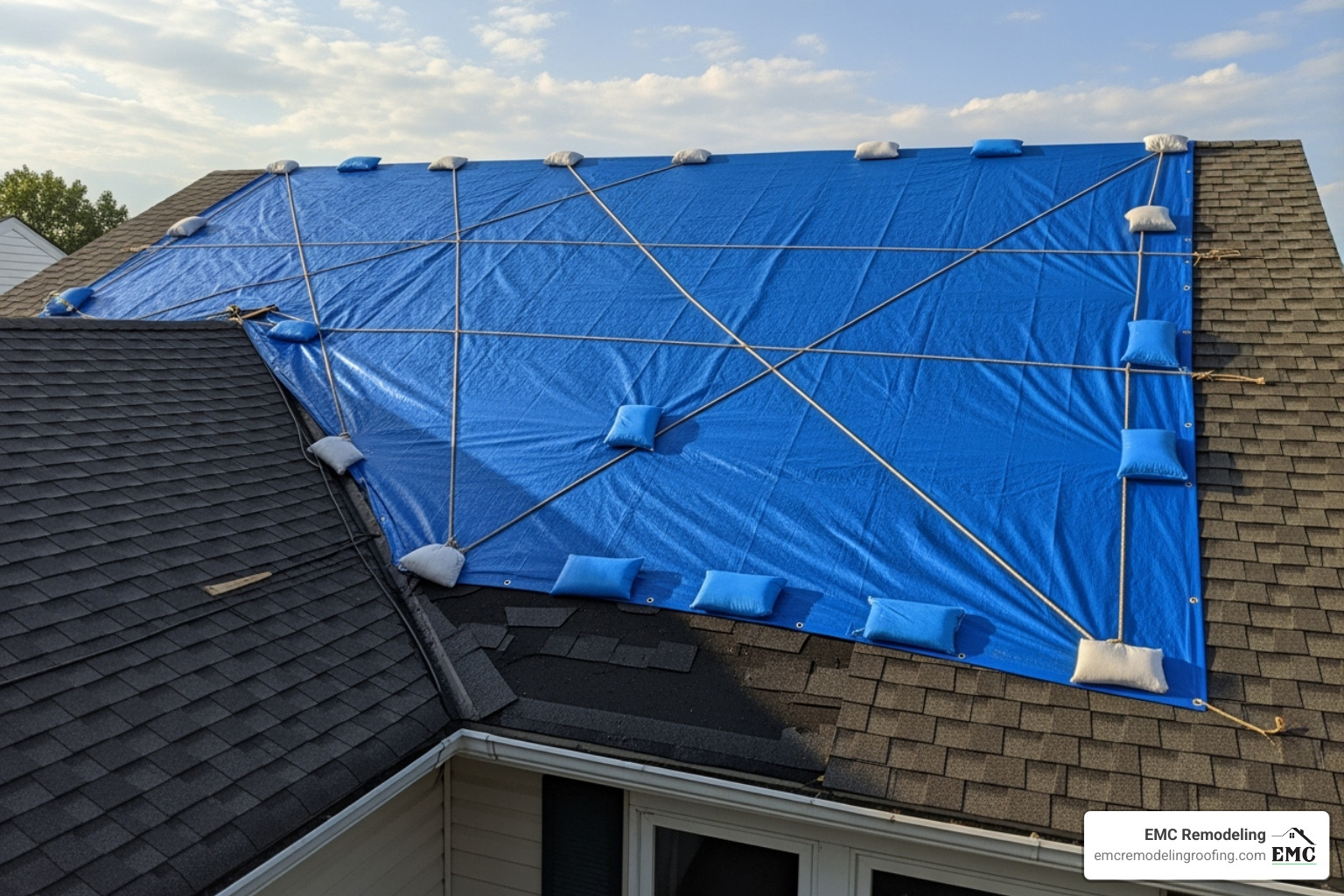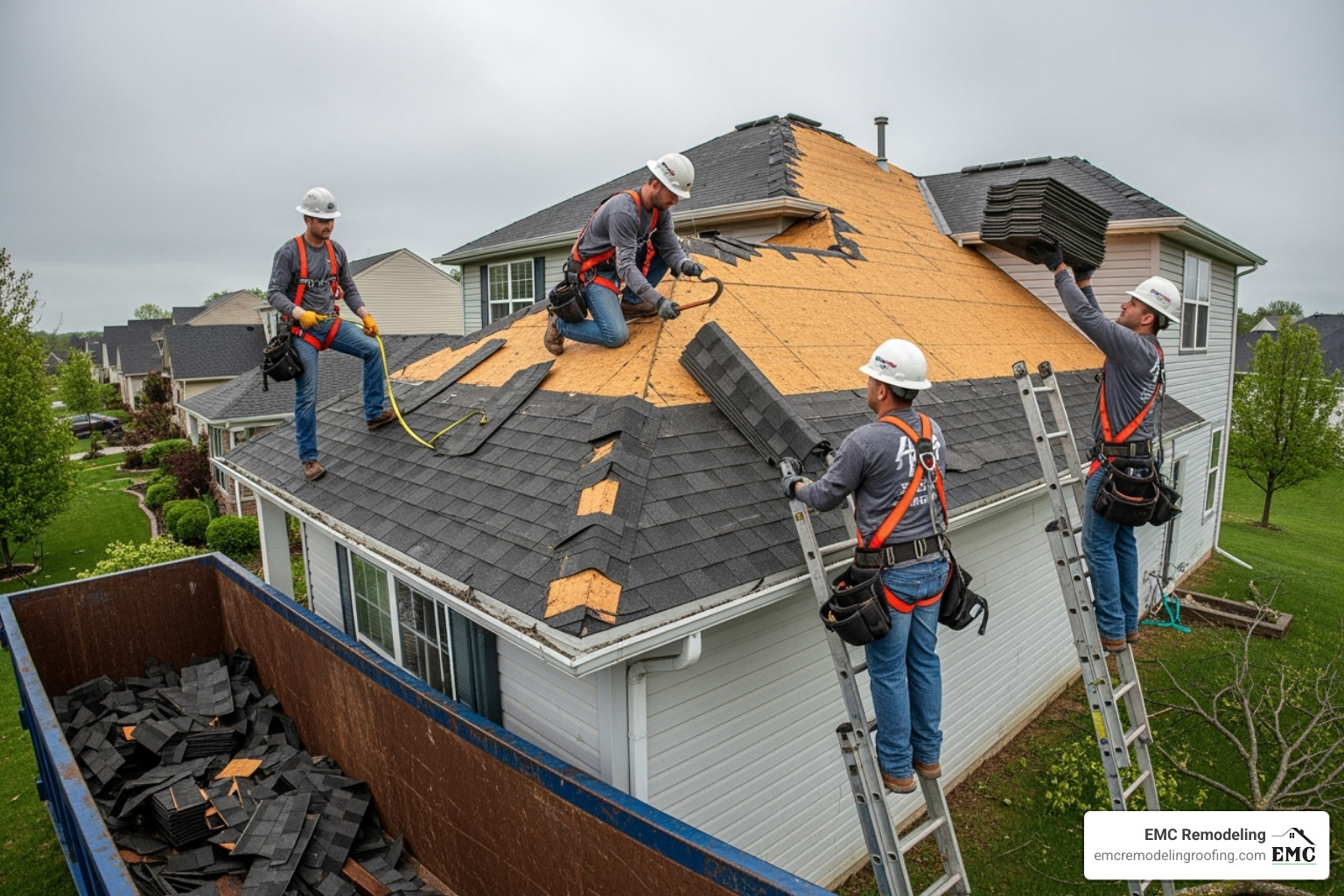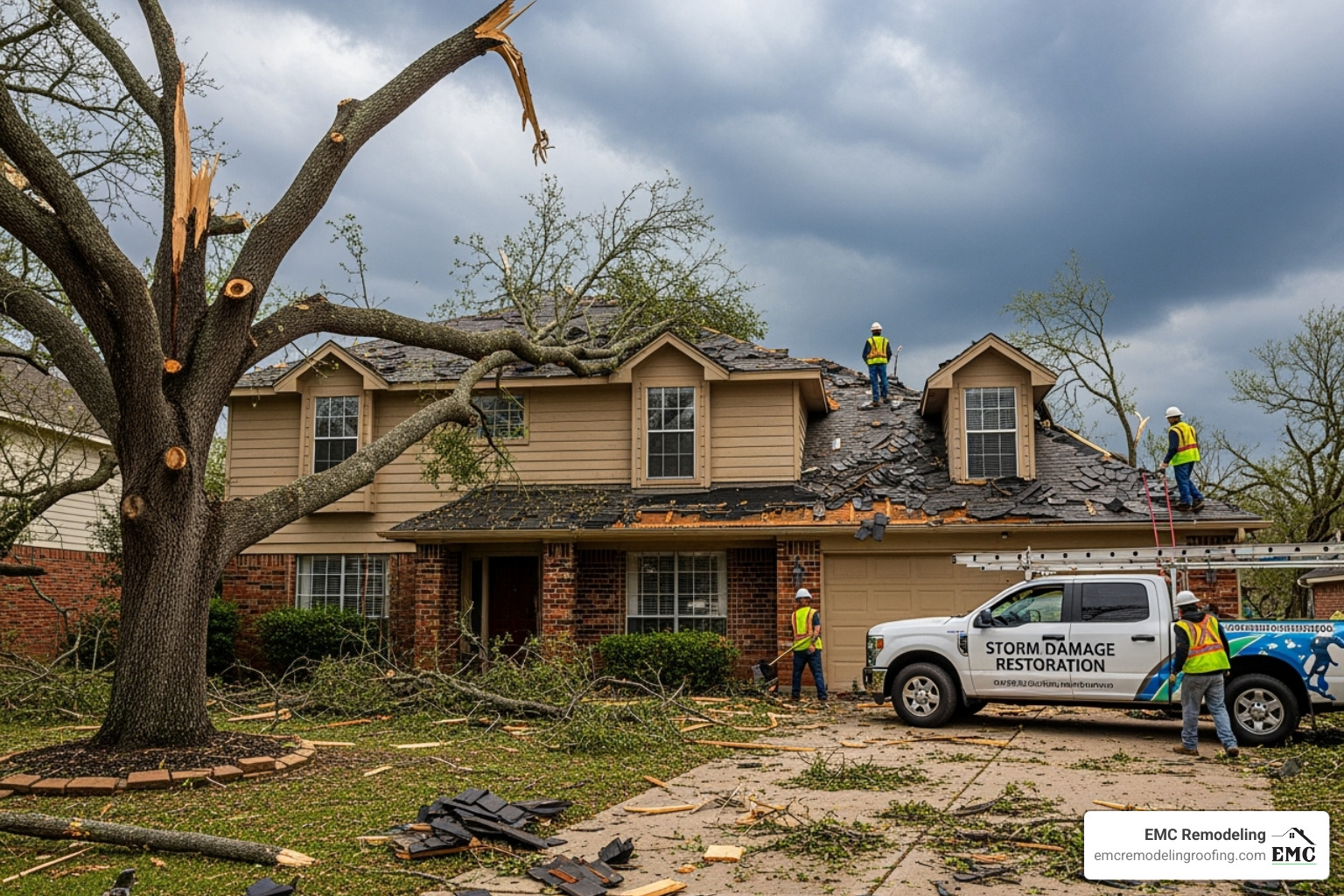The Aftermath of the Storm: Your Path to Full Recovery
The storm has passed, but the real challenge is just beginning. Residential storm damage restoration is the critical process of returning your home to its pre-loss condition after a severe weather event. For homeowners in Central Texas, partnering with a trusted roofing and remodeling company is the first step to a full recovery. Prompt action is crucial, as water damage can lead to mold growth in just 24-48 hours, turning a manageable repair into a catastrophic loss.
Professional restoration is a comprehensive service that includes:
- Emergency Response: Securing the property, tarping roofs, and boarding up openings.
- Damage Assessment: A thorough inspection of the roof, structure, and water intrusion.
- Water Mitigation: Extracting standing water and professionally drying the structure.
- Debris Removal: Safely disposing of all damaged materials.
- Reconstruction: Repairing or replacing the roof, siding, windows, and interiors to match pre-loss conditions.
This guide, created by the experts at EMC Remodeling & Roofing, will walk you through every step. With over 15 years of experience helping Central Texas families recover from severe weather, we work directly with insurance companies to ensure complete, quality repairs and restore your peace of mind.

Residential storm damage restoration further reading:
Safety First: Immediate Steps to Take After a Storm
After a storm, prioritizing safety is non-negotiable. Before you assess the damage, take a deep breath and follow these critical steps to protect your family.
- Stay Informed: Tune into local emergency broadcasts and wait for the all-clear from authorities before venturing outside. They are aware of widespread hazards like downed power lines or flooded roads.
- Check for Immediate Hazards: Approach your property with extreme caution. Treat any downed power lines as live and stay at least 35 feet away. If you smell gas or hear a hissing sound, evacuate immediately and call 911 or your gas provider from a safe distance.
- Assess Structural Stability: Look for leaning walls, sagging ceilings, or new cracks in the foundation. If you have any doubt about your home’s integrity, stay out. A 24/7 emergency roofing team can determine if it’s safe to enter.
- Shut Off Utilities: If it is safe to do so, turn off your electricity, water, and gas at the main switches to prevent fire or electrocution. Never wade through water to reach an electrical panel.
- Prevent Further Damage: Water intrusion causes exponential damage. Professional emergency roof patching and tarping can stop active leaks, while boarding up broken windows secures your home from weather and intruders.
- Document Everything: Use your phone to take extensive photos and videos of all damage, both inside and out. This documentation is vital for your insurance claim. Do not discard any damaged items until your adjuster has seen them.

Do Not Attempt DIY Roof Repairs
It’s tempting to climb on the roof with a tarp to stop a leak, but this is incredibly dangerous. Storm-damaged roofs are unstable, and falls are a leading cause of serious injury. Professional residential storm damage restoration crews have the safety equipment and training to secure your roof without risk.
While waiting for an emergency roofer, your job is to keep everyone safe. Wear protective gear like sturdy boots and gloves if you must be near debris. The few hours you wait for professional help could save your life. For immediate, safe, and expert assistance, call EMC Remodeling at (254) 262-2827.
Assessing the Aftermath: How to Spot Critical Storm Damage
Once your property is safe, a systematic damage inspection is your next step. Many homeowners spot obvious problems but miss the subtle, hidden issues that lead to the most expensive repairs. A professional roof inspection is always recommended after a major storm, but you can start with a careful walkthrough.
- Exterior: Check your roof for missing or cracked shingles, siding for holes, and windows for damaged frames or seals. Inspect gutters for dents and detachment.
- Interior: Look for water stains on ceilings, peeling paint on walls, and dampness near windows and doors. A musty odor is a clear sign of hidden moisture.
- Attic: This is ground zero for roof leaks. Check for damp insulation, water stains on wood, or any visible daylight shining through the roof deck.
Top 5 Overlooked Signs of Storm Damage:
- Granule Loss: Look for black, sand-like shingle granules in your gutters. This means your roof’s protective layer has been damaged, accelerating its aging.
- Bent Flashing: Damaged metal strips around chimneys and vents are a primary entry point for water.
- Hidden Attic Leaks: Water can saturate attic insulation and cause mold long before a stain appears on your ceiling.
- Compromised Window Seals: High winds can break window seals, leading to drafts and water infiltration that drive up energy bills.
- Small Siding Cracks: Hairline cracks in siding allow moisture to get behind it, leading to rot and mold inside your walls.

Identifying Wind vs. Hail Damage
- Wind Damage: Look for lifted, creased, or completely missing shingles. Wind creates an uplift force that breaks the adhesive seal holding shingles down.
- Hail Damage: This appears as dark, round dents or bruises on shingles where hail has displaced the protective granules. Prompt hail damage roof repair is crucial because even minor impacts can drastically shorten your roof’s lifespan.
Water is the silent destroyer in any storm. Water damage is a common consequence of storms, often leading to mold growth if not addressed within 24-48 hours. Hidden moisture requires immediate attention from attic leak repair specialists to prevent a small leak from becoming a major health and structural problem.
The Professional Residential Storm Damage Restoration Process
If storm damage involves water intrusion, structural issues, or requires specialized equipment, professional help is essential. DIY repairs often lead to bigger problems like mold growth and voided warranties. The goal of professional residential storm damage restoration is to ensure your home is thoroughly dried, properly rebuilt, and safe for your family.
The process follows several key phases:
- Water Extraction: Using powerful pumps, technicians remove standing water to prevent it from seeping deeper into your floors, walls, and foundation.
- Structural Drying: Industrial-grade dehumidifiers and air movers are strategically placed to pull moisture from hidden areas. This step is critical for preventing mold.
- Debris Removal: Hazardous storm debris, including broken glass, twisted metal, and waterlogged materials, is safely cleared and disposed of.
- Reconstruction: The final phase involves repairing or replacing damaged roofs, siding, windows, and interiors to restore your home to its pre-loss condition.

What to Expect from a Reputable Restoration Company
After a storm, disaster areas are often flooded with untrustworthy “storm chasers.” When finding a roofing contractor, look for these signs of a reputable company:
- Certifications: Technicians should be IICRC-certified for water damage and mold remediation.
- Licensed & Insured: The company must have general liability and workers’ compensation insurance to protect you.
- Local Reputation: Choose a company with deep roots in your community. As one of the roofing companies Temple TX residents trust, we’ll be here long after the work is done.
- Written Estimates: Never accept a verbal quote. Demand a detailed, written scope of work.
- Clear Communication & Warranties: A good contractor provides regular updates and stands behind their work with solid warranties.
- 24/7 Emergency Services: Storms don’t wait for business hours. A reliable company answers your call anytime. Contact us at (254) 262-2827 for immediate help.
During reconstruction, our focus is on structural integrity and matching materials for a seamless finish, adhering to all local building codes. For more on rebuilding, FEMA offers excellent Resources for Repairing, Retrofitting and Rebuilding After Severe Storms.
Navigating the Maze: Storm Damage and Your Insurance Claim
Dealing with insurance after a storm can be daunting, but understanding the process is key to a smooth recovery. Your insurance policy is a crucial partner in your residential storm damage restoration journey.
First, understand your coverage. Homeowners insurance typically covers damage from wind and hail, but flood damage requires a separate policy. This distinction is critical, as standard policies will not cover damage from rising water.
Follow these steps to ensure a successful claim:
- File Promptly: Contact your insurance provider as soon as it’s safe. Most policies have a limited timeframe for reporting storm damage.
- Provide Thorough Documentation: The photos and videos you took immediately after the storm are your most powerful evidence. Keep a detailed file of all damage and any receipts for emergency repairs.
- Meet the Adjuster: Walk through the property with the insurance adjuster and point out every area of concern. We recommend having your contractor present during this meeting to ensure no damage is overlooked.
- Review the Estimate Carefully: Insurance estimates may not account for hidden damage. If the estimate seems too low, you have the right to question it. A professional contractor can provide a competing quote that details the full scope of necessary work.
Navigating the insurance roof claims process is complex. At EMC Remodeling, we have extensive experience working directly with insurance companies. We act as your advocate, providing the detailed documentation and justification needed to secure a fair settlement that covers all necessary repairs.
Don’t let insurance headaches add to your stress. If you’re feeling overwhelmed or unsure about your coverage, call us at (254) 262-2827 for a free inspection and expert guidance.
Fortifying Your Home: Proactive Measures to Prevent Future Damage
Once your residential storm damage restoration is complete, you can take proactive steps to make your home more resilient to future storms. These upgrades are an investment in peace of mind and can often lower your insurance premiums.
Consider these key fortifications:
- Impact-Resistant Shingles: Class 4 rated shingles are engineered to withstand hail and high winds far better than standard materials. When combined with reinforced roofing techniques, they create a powerful defense.
- Upgrade Windows and Doors: Impact-resistant windows, storm shutters, and a reinforced garage door protect your home from flying debris and catastrophic wind pressure.
- Maintain Gutters and Drainage: Clean your gutters at least twice a year to prevent water from backing up under your roof or pooling around your foundation.
- Schedule Regular Inspections: A professional roof and attic inspection twice a year can identify minor issues before they become major vulnerabilities in a storm.
In some states, like Florida, insurers are required by law to offer discounts for wind mitigation features. Many Texas insurers offer similar incentives, which can help offset the cost of these important upgrades.
Pre-storm preparation is also vital. Trim weak tree branches, secure outdoor furniture, and create an emergency kit. By taking these steps, your home will be better prepared for whatever nature throws at it. And if damage does occur, you’ll know you have a trusted Central Texas roofing partner ready to help.
Frequently Asked Questions about Storm Damage Repair
How soon should I get my roof inspected after a storm?
Immediately. Do not wait. Even if your roof looks fine from the ground, hidden damage from wind or hail can lead to severe leaks, mold, and structural issues over time. A prompt, professional inspection provides critical documentation for your insurance claim and allows you to address small problems before they become costly disasters. A timely call to a roofer in Temple, TX is your best first defense.
What happens if I ignore minor roof damage?
There is no such thing as “minor” roof damage. A single compromised shingle creates an entry point for water, which can lead to widespread rot, mold, and structural failure. Ignoring a small issue today almost guarantees a much larger, more expensive problem tomorrow, potentially turning a simple repair into a full roof replacement. Water damage only gets worse over time.
Can I handle residential storm damage restoration myself?
While minor debris cleanup is fine, true residential storm damage restoration should be left to professionals. The process requires specialized equipment for water extraction and drying, as well as the expertise to perform safe and effective roof repairs. DIY restoration is dangerous, can void material warranties, and may jeopardize your insurance claim. Consulting with trained storm damage specialists is an investment in your home’s health and your family’s safety. For a free, no-obligation inspection, call us 24/7 at (254) 262-2827.
Your Partner in Recovery: Restoring Your Peace of Mind
The journey of storm recovery can feel overwhelming, but you don’t have to face it alone. Choosing the right partner for your residential storm damage restoration is about finding a team that understands what you’re going through and treats your home with care.
That’s our commitment at EMC Remodeling. As a family-operated business in Temple, TX, we have served our neighbors in Lago Vista, Cedar Park, Leander, Georgetown, Killeen, Belton, Pflugerville, and Salado for over 15 years. When you call us, you’re not getting a call center; you’re talking to the people who will work on your home.
Our goal is not just to repair your property, but to restore your peace of mind. We work directly with your insurance company, handle the complexities of the claim, and ensure every repair is completed to the highest standard of craftsmanship. We want you to feel secure in your home again.
For immediate assistance or a free, no-obligation inspection, explore our comprehensive storm damage repair services. We’re here when you need us most, ready to help you rebuild—stronger and safer than before.
